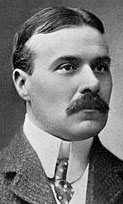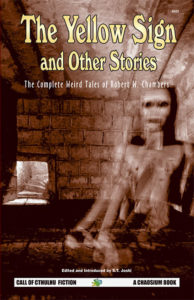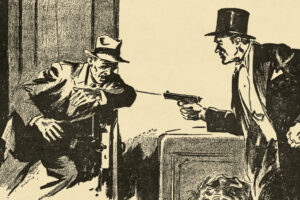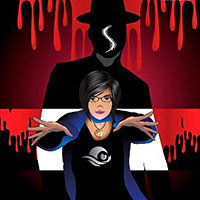
I think more people who have read horror works that are considered “Lovecraftian” have probably heard of the King in Yellow, either the character or the play. Less well known is the person who created it — Robert W. Chambers (1865-1924) — not surprising as the bulk of his writing was not macabre. Though what he did write in that area is pretty good.
Chambers only wrote some weird or macabre stuff. While he started out as an illustrator, he moved to fiction, and wrote in a wide range of genres. The bulk of his work — and where he made his fortune — was in writing romance fiction. In his later years he wrote historical fiction. It would be as if Stephen King just dabbled in weird fiction, but mainly wrote Harlequin Romance novels. H.P. Lovecraft praised his work, but was disappointed that he didn’t continue to do weird fiction.
His weird fiction works seem limited to the King in Yellow, The Maker of Moons, The Mystery of Choice, The Tree of Heaven, and a few others, along with his science fictional works in In Search of the Unknown and Police! These last two are about a zoologist who discovers monsters.
Of course, his most well known work is the short story collection The King in Yellow (1895), though the stories are considered Art Nouveau. However, only about half of the stories are weird, and share the use of the sinister banned play, The King in Yellow. What is known about the play is that those who read it go mad, though this doesn’t occur until they reach the second act. The play concerns the character “The King in Yellow” who lives in dark Carcosa and seems a herald for madness. We are given just snippets from the play. There is also something called the “Yellow Sign.” Of course, other authors since then have used the play, character, and sign in their own works.
 As noted, not all the stories in the collection concern the play. Only the first four, plus a sequence of poems, do. The first of these, “The Repairer of Reputations” is set in a bizarre future 1920s America. However, the narrator is an unreliable source, as he had been in an insane asylum, plus he has read the play. He hopes, with the help of the so-called “Repairer” to be restored as the heir to the “Imperial Dynasty of the United States”!
As noted, not all the stories in the collection concern the play. Only the first four, plus a sequence of poems, do. The first of these, “The Repairer of Reputations” is set in a bizarre future 1920s America. However, the narrator is an unreliable source, as he had been in an insane asylum, plus he has read the play. He hopes, with the help of the so-called “Repairer” to be restored as the heir to the “Imperial Dynasty of the United States”!
“The Mask” is set in Paris, and is a weird little story of art, love, and science. Also set in Paris is “In the Court of the Dragon,” where the narrator is haunted or pursued by a sinister church organ player.
In “The Yellow Sign,” a young artist is pursued by a sinister churchyard watcher who resembles a coffin worm.
The Maker of Moons is another collection of stories, taking its name from the first, about a sinister Asian who wants to wreck the U.S. with counterfeit gold. As with The King in Yellow, not all the stories are weird.
A couple of others to check out are Slayer of Souls and The Tracer of Lost Persons. Some of Chambers works were reprinted in Famous Fantastic Mysteries, so he is kind of a pulp author.
For those wishing to read his works, there are several choices. There are still reprints of The King in Yellow out there, as well as some of his other works. But if you just want to focus on his weird fiction works and not deal with the others in the original volumes, you have some options. For an excellent single volume, there is The Yellow Sign and Other Stories: The Complete Weird Fiction of Robert W. Chambers from Chaosium. For a more complete collection is the four-volume The Collected Supernatural and Weird Fiction of Robert W. Chambers from Leonaur.




THE KING IN YELLOW and Robert Chambers enjoyed a surge in popularity in recent years thanks to the memorable Season 1 of the HBO series “True Detective” which used much of the mythology of the macabre, existential horror Chambers dreamed up. The series extensively references The King In Yellow and Carcosa.